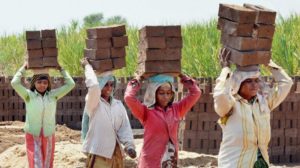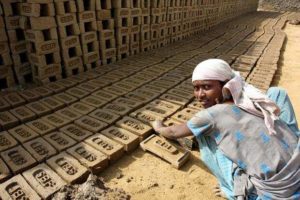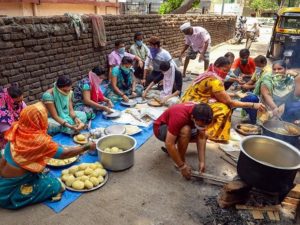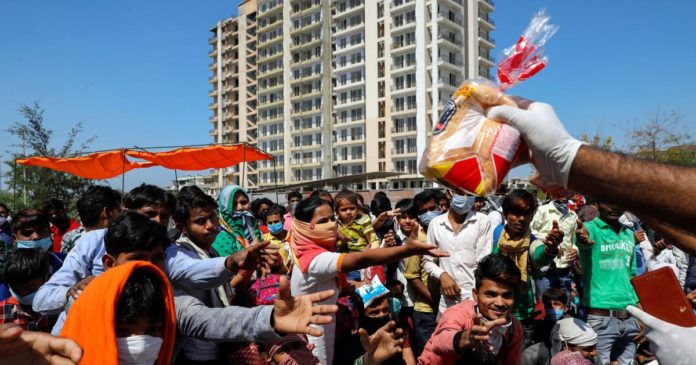The Prime Minister of India, Mr. Narendra Modi, declared a countrywide lockdown on 24th March 2020. This lockdown, one of the largest in human history, was issued in wake of the COVID-19 pandemic. Out of 1.3 billion people, the poorest and the most vulnerable were scornfully overlooked, as if the precariousness of their existence was of their own making.
Urban Poor and Precarious Work Environment
With the sudden stoppage of all public transport, production activities, markets, and private enterprises, the invisible underbelly of the city exploded onto the streets, highways, bus and railway stations. The millions of migrants that keep the Indian economy and its urbane affluence afloat were left with no money, shelter, food, and means of survival. Most were forced to choose between the horrors of launching on an impossibly long march to their village homes or languishing in the labyrinth of the urban slum squalor, cut off from the bare necessities essential for survival. Migrants were left bereft, forced to improvise in the face of absolute deprivation and precarity. Some desperate souls entrusted their fates to the dark and musty crevices of transport vehicles, hiding under cartons of vegetables, fruits, and other essential goods, while some were stuffed in milk tankers and trailers. 20 migrant labourers have perished in this exodus, unforeseen by the country since its partition in 47.
 To understand why these migrants are so desperate to go home, we must first recognize the character of the migrant labour force. An International Labour Organization report published in 2017 concluded that 92% of India’s workforce is in some or the other form of informal employment. This form of employment entails no social security, little to no job security and no juridical proof of employment. Each informal worker embodies multiple identities due to the precarity of their work. They can be agricultural workers for a few months in a year and urban informal workers for the rest. The Stranded Workers Action Network recently published a report based on their rapid assessment of 11,159 workers in which 79 percent of the sampled workers were daily wage factory/construction workers.
To understand why these migrants are so desperate to go home, we must first recognize the character of the migrant labour force. An International Labour Organization report published in 2017 concluded that 92% of India’s workforce is in some or the other form of informal employment. This form of employment entails no social security, little to no job security and no juridical proof of employment. Each informal worker embodies multiple identities due to the precarity of their work. They can be agricultural workers for a few months in a year and urban informal workers for the rest. The Stranded Workers Action Network recently published a report based on their rapid assessment of 11,159 workers in which 79 percent of the sampled workers were daily wage factory/construction workers.
Such workers frequently move from their villages to urban areas following swells and troughs in labour demand cycles. As employment prospects in villages dwindle post-harvest, urban infrastructural development begins post-monsoon. This coinciding rise and fall in labour demand ensure that surplus labour is always present, driving the individual cost of each labourer well below minimum wage. When migrant informal workers enter the urban economy, most of them are absorbed by the construction industry. The construction industry is known the world over for its brutality and umpteen profitability, with one factor constantly reinforcing the character of the other. Following a long chain of subcontracting, wages are reduced to a mere trickle by the time they reach the migrant workforce on the very bottom. Due to subcontracting, administrative and labour costs are reduced substantially while also ensuring the workforce remains highly competitive, productive and profitable.
It is also important to recognize that the relations between the labour and their thekedars (contractors) is not a typical capitalist-proletariat relation, but is, in fact, feudal. Feudal labour relations imply that ‘wages’ are notional and promissory. Workers depend on the contractors for provisioning food, shelter and basic services. A nominal subsistence daily wage is given to the workers which is a fraction of the promised wages while hiring. Many workers
 are only paid when the construction season is over in lump sum, after the contractors have taken their cut. Cases of contractors disciplining workers with abuse and by holding on to wages are all too common. Dissenting workers are shunned by the contractor all together and subsequently blacklisted. For many of these workers, finding employment again is rendered impossible as most contractors know each other and often belong to similar identity-based communities.
are only paid when the construction season is over in lump sum, after the contractors have taken their cut. Cases of contractors disciplining workers with abuse and by holding on to wages are all too common. Dissenting workers are shunned by the contractor all together and subsequently blacklisted. For many of these workers, finding employment again is rendered impossible as most contractors know each other and often belong to similar identity-based communities.
These workers do not live in slums but rather live inside construction labour colonies located inside construction sites. These colonies are characterized by tiny huts or tin sheds, often compartmentalized for multiple families by hanging saris. Workers in these colonies are completely cut-off from mainstream society as most construction sites are barricaded with high fences and marked as private properties. The workers are often dependent on their contractors for water, sanitation, and electricity. Provisioning of these is liable to construction commencing unobstructed. With all construction activities on hiatus, living on such construction sites is rendered impossible. Distribution of grains cannot sustain these workers as many single men depend on canteens for food. Those who migrate with their families cook by procuring groceries in small amounts daily as storage provisions are often absent, largely because such colonies are often infested with rats.
 The situation of workers in garment, food and leather factories based in slums is similar. For these workers, their workplace is also their place of stay, their issues are fundamentally different. Most live in bachelor pads where groups of upwards of 15 people are made to sleep in rooms barely 100ft2 in size. Such workers stick out like a sore thumb in the city because they are easily recognized as outsiders. Negotiating with police for permissions and competing with established slum dwellers for handouts is challenging for such workers since they do not speak the local language, they cannot navigate the city well and they are often treated harshly due to their alien status. Most of these workers are not registered either and they often do not own bank accounts or possess ration cards.
The situation of workers in garment, food and leather factories based in slums is similar. For these workers, their workplace is also their place of stay, their issues are fundamentally different. Most live in bachelor pads where groups of upwards of 15 people are made to sleep in rooms barely 100ft2 in size. Such workers stick out like a sore thumb in the city because they are easily recognized as outsiders. Negotiating with police for permissions and competing with established slum dwellers for handouts is challenging for such workers since they do not speak the local language, they cannot navigate the city well and they are often treated harshly due to their alien status. Most of these workers are not registered either and they often do not own bank accounts or possess ration cards.
Strengthen Community initiatives for local welfare programs
 How can a centralized, weakened and top-heavy institutional apparatus cater to the needs of such workers numbering in the millions? Tracking workers and providing DBTs cannot be the only solution as these policy interventions often exclude the persons who are most desperate for survival. A plea from the state to employers of these workers, urging them to provide them with bare necessities is certainly not enough. Reducing hardworking, honest-wage earning labour into beggars lining up for handouts cannot be considered welfare. In times of such complexity, it is the civil society network that is mobilizing aid and support for such workers who have been abandoned by their employers and their government. Strengthening civil society/community-led initiatives can be a legitimate strategy for extending welfare services. Many community-based organizations have reached out to construction sites personally to hand out medicines and food.
How can a centralized, weakened and top-heavy institutional apparatus cater to the needs of such workers numbering in the millions? Tracking workers and providing DBTs cannot be the only solution as these policy interventions often exclude the persons who are most desperate for survival. A plea from the state to employers of these workers, urging them to provide them with bare necessities is certainly not enough. Reducing hardworking, honest-wage earning labour into beggars lining up for handouts cannot be considered welfare. In times of such complexity, it is the civil society network that is mobilizing aid and support for such workers who have been abandoned by their employers and their government. Strengthening civil society/community-led initiatives can be a legitimate strategy for extending welfare services. Many community-based organizations have reached out to construction sites personally to hand out medicines and food.
With large hearts, immense sensitivity and a capacity to share whatever little that could be spared, the poor have made the poor’s survival possible. This is the true nature of our society, where service and a will to help reach beyond class, caste, creed, religion, and gender. Unfortunately, the state continues taking these efforts either for granted or tramples on them with Draconian laws and policies. Greater sensitivity, non-interference, and cooperation from state authorities become pertinent in such desperate times, but it seems even this is a little too much to ask for. The lockdown extension announced on March 14th came as another severe blow to the urban poor’s underbelly. The fortunate who had received food donations keeping March 14th as the lockdown deadline in mind have been suddenly left stranded with supplies nearing exhaustion yet again.




























